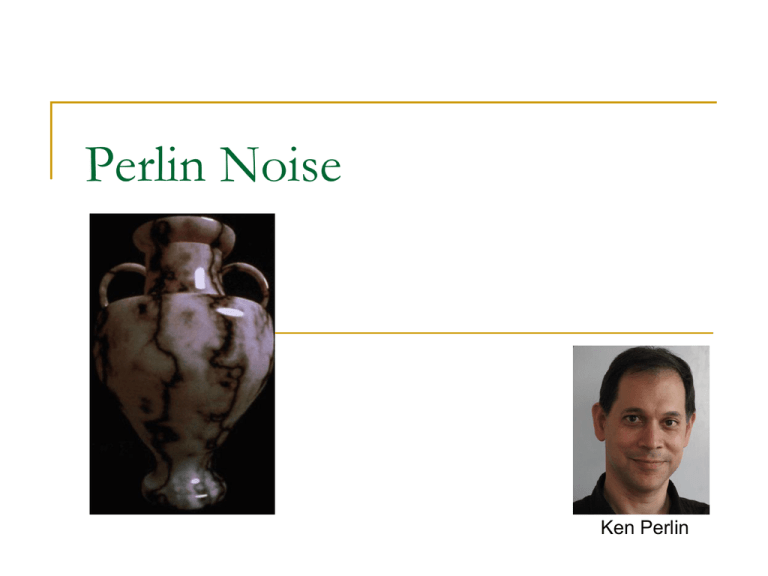Perlin Noise
advertisement

Perlin Noise Ken Perlin Introduction Many people have used random number generators in their programs to create unpredictability, making the motion and behavior of objects appear more natural But at times their output can be too harsh to appear natural. The Perlin noise function recreates this by simply adding up noisy functions at a range of different scales. Fall 2012 Wander is also an application of noise 2 Gallery 3D Perlin Noise Procedual bump map Fall 2012 3 Fall 2012 4 Fall 2012 5 Noise Functions A noise function is essentially a seeded random number generator. It takes an integer as a parameter (seed), and returns a random number based on that parameter. f : Z 1,1 Fall 2012 6 Example After interpolation … Fall 2012 7 Linear Interpolation Interpolation function Linear_Interpolate(a, b, x) return a*(1-x) + b*x Cosine Interpolation Cubic Interpolation Fall 2012 function Cosine_Interpolate(a, b, x) ft = x * 3.1415927 x = 0, ft = 0, f = 0 f = (1 - cos(ft)) * .5 x = 1, ft = p, f = 1 return a*(1-f) + b*f 8 Interpolation 1 f ( x) 1 cos px 2 Fall 2012 f ( x) 3x 2x 2 3 Similar smooth interpolation with less computation 9 Smoothed Noise Apply smooth filter to the interpolated noise 1 2 1 2 4 2 1 2 1 Fall 2012 10 Amplitude & Frequency The red spots indicate the random values defined along the dimension of the function. frequency is defined to be 1/wavelength. Fall 2012 11 Persistence You can create Perlin noise functions with different characteristics by using other frequencies and amplitudes at each step. Fall 2012 12 Fall 2012 13 Creating the Perlin Noise Function Take lots of such smooth functions, with various frequencies and amplitudes Idea similar to fractal, Fourier series, … Add them all together to create a nice noisy function. Fall 2012 14 Perlin Noise (1D) Summary Pseudo random value at integers Cubic interpolation Smoothing Sum up noise of different frequencies Fall 2012 15 Perlin Noise (2D) Gradients: random unit vectors Fall 2012 16 Perlin Noise (1D) rx0 bx0 Here we explain the details of Ken’s code rx1 (= rx0 - 1) arg bx1 1. Construct a [-1,1) random number array g[ ] for consecutive integers 2. For each number (arg), find the bracket it is in, [bx0,bx1) We also obtain the two fractions, rx0 and rx1. 3. Use its fraction t to interpolate the cubic spline (sx) 4. Find two function values at both ends of bracket: rx0*g1[bx0], rx1*g1[bx1] as u, v 5. Linearly interpolate u,v with sx noise (arg) = u*(1-sx) + v*sx Fall 2012 17 Note: zero values at integers The “gradient” values at integers affects the trend of the curve 0.1 0.08 0.06 0.04 g0 g1 g2 g3 g4 0.38 0.54 0.3 0.23 0.45 0.02 數列1 0 -0.02 0 1 2 3 4 5 -0.04 -0.06 -0.08 Fall 2012 18 Interpolation:2D 3 p 2 2 p3 p Interpolant Bilinear interpolation b a S y 3 y y0 2 y y0 2 3 Noise( x, y ) a S y b a Fall 2012 19 Ken’s noise2( ) Relate vec to rx0,rx1, ry0,ry1 b a Fall 2012 20 2 dimensions Fall 2012 21 Using noise functions Sum up octaves Sum up octaves using sine functions Blending different colors Blending different textures Fall 2012 22 Other Usage of Noise Function (ref) sin(x + sum 1/f( |noise| )) Fall 2012 23 Applications of Perlin Noise 1 dimensional : Controlling virtual beings, drawing sketched lines 2 dimensional : Landscapes, clouds, generating textures 3 dimensional : 3D clouds, solid textures Fall 2012 24 2D Noise: texture and terrain Fall 2012 25 Use Perlin Noise in Games (ref) Texture generation Texture Blending Fall 2012 26 Animated texture blending Terrain Fall 2012 27 Variations (ref) Standard 3 dimensional perlin noise. 4 octaves, persistence 0.25 and 0.5 create harder edges by applying a function to the output. mixing several Perlin functions marbly texture can be made by using a Perlin function as an offset to a cosine function. texture = cosine ( x + perlin(x,y,z) ) Very nice wood textures can be defined. The grain is defined with a low persistence function like this: g = perlin(x,y,z) * 20 grain = g - int(g) Fall 2012 28 Noise in facial animation Math details Fall 2012 29 Simplex Noise (2002) New Interpolant Fall 2012 More efficient computation! Picking Gradients 30 Simplex Noise (cont) Simplex Grid Moving from interpolation to summation (more efficient in higher dimension noise) Fall 2012 31 References Perlin noise (Hugo.elias) Classical noise implementation ref Making noise (Perlin) Perlin noise math FAQ How to use Perlin noise in your games Simplex noise demystified Fall 2012 32 Project Options Experiment with different noise functions 1D noise: NPR sketch 2D noise: infinite terrain 3D noise: clouds Application to foliage, plant modeling Fall 2012 33 Alternate formula Fall 2012 34 Fractal Geometry (Koch) Koch snowflake Koch curve Fall 2012 35 Fractal Geometry (Mandelbrot set) Fall 2012 36 Fourier Analysis Fall 2012 37





